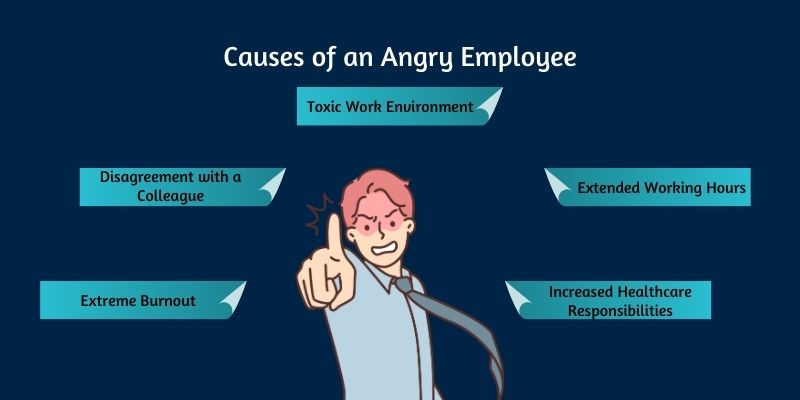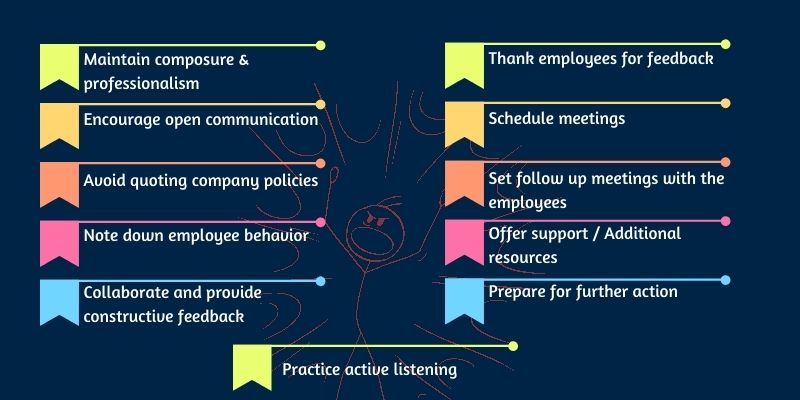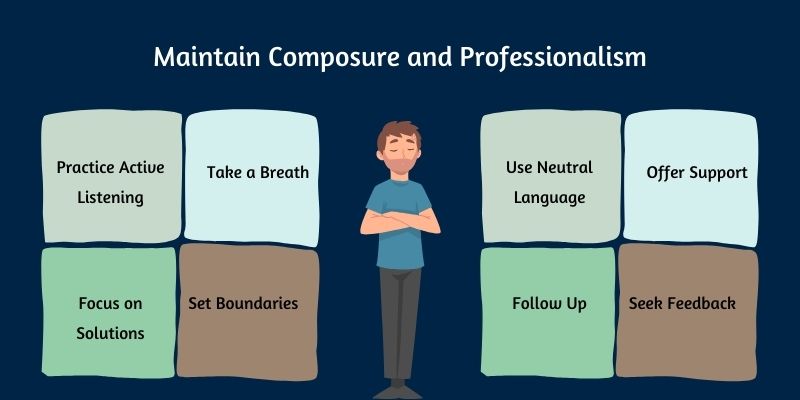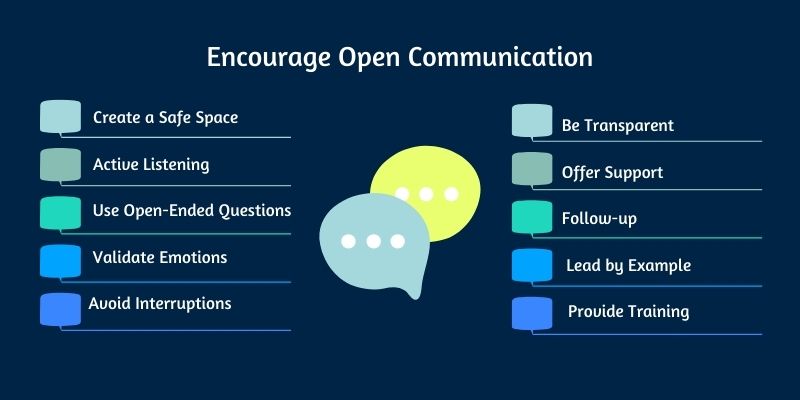
How To Deal With Angry Employees
Dealing with an angry employee can be one of the most challenging and unpleasant tasks for managers and HR professionals.
It requires a knack, empathy, and a strategic approach to defuse the situation while maintaining professionalism and courtesy.
Understanding the root causes of anger, whether stemming from a toxic work environment or interpersonal conflicts, is essential for effectively addressing the issue without damaging relationships within the team.
Employees undergo various stressors, including extended working hours, burnout, financial strains, and increased caregiving responsibilities. This is the main reason understanding how to deal with angry employees has become an important skill.
Recognizing the impact of these external factors on employee well-being is crucial for managers seeking to provide support and guidance to their team members.
In today’s dynamic workplace, where personal and professional boundaries often blur, managers must be attuned to employees’ diverse challenges and proactively address their concerns with sensitivity and understanding.
While organizations may have established policies and procedures for handling employee grievances, specific tactics can prove invaluable in managing angry employees effectively.
From active listening and conflict resolution techniques to offering flexibility and support, managers must employ a range of strategies tailored to each employee’s specific needs and circumstances.
By prioritizing open communication, empathy, and a collaborative approach to problem-solving, managers can foster a culture of trust, respect, and mutual support within the organization, ensuring the well-being and satisfaction of their employees.
Causes of an Angry Employee

Various factors can contribute to employee anger, frustration, and resentment, including a toxic work environment, interpersonal conflicts, excessive workload, extended working hours, burnout, and caregiving responsibilities.
- Toxic Work Environment: A toxic work environment, often fueled by negative behaviors or attitudes from colleagues or superiors, can significantly contribute to employee anger. Whether it’s due to micromanagement, lack of support, or bullying, toxic workplace dynamics can destroy morale and trigger employee frustration and resentment.
- Disagreement with a Colleague: Interpersonal conflicts and disagreements with colleagues can also lead to employee anger. Whether it’s a difference in opinions, conflicting work styles, or unresolved issues, friction between coworkers can escalate into anger if not addressed promptly and effectively.
- Extended Working Hours: Excessive workload and extended working hours can exacerbate stress and overwhelm, ultimately leading to employee anger. Employees feeling overworked and undervalued can result in heightened frustration and dissatisfaction with their jobs and the organization.
- Extreme Burnout: Burnout, characterized by emotional exhaustion, cynicism, and reduced effectiveness at work, significantly contributes to employee anger. When employees feel overwhelmed and drained by their job responsibilities, they may become more prone to outbursts of anger as a coping mechanism for their stress and frustration.
- Increased Healthcare Responsibilities: Employees may experience anger and resentment stemming from increased healthcare responsibilities for family members. Balancing caregiving duties with work commitments can be challenging, leading to guilt, frustration, and overwhelm, especially if adequate support and flexibility are lacking in the workplace.
Identifying and addressing the underlying issues is crucial for fostering a supportive and respectful work environment, promoting employee well-being, and ensuring organizational success.
This approach enables employers and managers to mitigate workplace anger effectively while empowering employees to thrive, feel valued, and be heard.
11 Tips on How to Deal with Angry Employees as a Manager

As a manager, dealing with employees suffering from anger requires empathy, assertiveness, and professionalism.
Managers can effectively de-escalate tense situations and foster a more positive and productive work environment by maintaining composure in workplace conflicts. Here are some practical tips for managing anger in the workplace:
Let’s explore these tips in detail so you can effectively implement them to deal with angry employees.
1. Maintain Composure and Professionalism

Maintaining composure as a manager is crucial for diffusing volatile situations and maintaining credibility and respect among employees.
When faced with an angry employee, avoiding reacting impulsively or defensively is essential. Instead, step back, breathe deeply, and maintain a calm demeanor.
Avoid escalating the situation further by responding with empathy and active listening, acknowledging the employee’s concerns, and validating their emotions.
By modeling professionalism and emotional intelligence, managers can set a positive example for their team and establish trust and confidence in their leadership abilities.
Here are some effective tips for maintaining composure and professionalism while dealing with angry employees:
- Take a Breath: Before responding, take a moment to breathe deeply and center yourself. This brief pause can help you regain composure and prevent emotional reactions that may escalate the situation.
- Focus on Solutions: Shift the focus from the emotion to the issue. Collaborate with the employee to identify solutions or compromises that address their concerns constructively.
- Set Boundaries: Maintain professional boundaries by avoiding personal attacks or becoming emotionally involved in the conflict. Keep the conversation focused on the facts and behaviors, rather than engaging in personal arguments.
- Use Neutral Language: Choose your words carefully to convey empathy and understanding while maintaining a neutral tone. Avoid inflammatory language or blaming statements that may exacerbate tensions.
- Offer Support: Express your willingness to help the employee resolve their concerns. This demonstrates your commitment to their well-being and fosters trust and cooperation.
- Follow-Up: After the initial conversation, follow up with the employee to ensure the issue has been addressed satisfactorily. This demonstrates your commitment to resolving conflicts and maintaining open lines of communication.
- Seek Feedback: Reflect on the interaction and seek feedback from trusted colleagues or mentors on how you handled the situation. Use this feedback to continuously improve your skills in dealing with anger professionally.
2. Encourage Open Communication

Fostering open communication is essential for effectively managing anger in the workplace. Encourage employees to express their concerns and grievances in a safe and supportive environment.
Actively listen to their feedback without judgment and demonstrate a willingness to address their issues constructively. By creating a culture of open communication, you empower employees to voice their concerns early, preventing anger from festering and escalating into larger conflicts.
Additionally, transparent communication builds trust and strengthens relationships, enabling teams to work together more effectively towards common goals.
Regularly solicit employee feedback and implement strategies to address any underlying issues, promoting a culture of collaboration, respect, and mutual understanding.
- Create a Safe Space: Establish an environment where employees feel comfortable expressing their thoughts and emotions without fear of judgment or reprisal. Assure them that their concerns will be heard and addressed respectfully.
- Use Open-Ended Questions: Ask open-ended questions to encourage employees to elaborate on their concerns and provide additional context. This allows for more meaningful dialogue and helps uncover underlying issues contributing to their anger.
- Validate Emotions: Acknowledge and validate the emotions the employee expresses, even if you disagree with their perspective. Validating their feelings demonstrates empathy and helps establish rapport.
- Avoid Interruptions: Refrain from interrupting or dismissing the employee’s concerns, even if you disagree. Allow them to express themselves fully before offering your perspective or proposing solutions.
- Be Transparent: Be open and transparent about organizational decisions, policies, and processes. Transparency builds trust and reduces uncertainty, fostering a more positive and collaborative work environment.
- Offer Support: Offer support and resources to help employees address the underlying issues contributing to their anger. This may include access to counseling services, conflict resolution training, or additional support from management.
- Follow-up: Follow up with the employee after the initial conversation to ensure their concerns have been addressed satisfactorily. Regular check-ins demonstrate your commitment to open communication and employee well-being.
- Lead by Example: Model open communication by actively seeking employee feedback, being receptive to constructive criticism, and addressing concerns promptly and transparently. Your behavior sets the tone for communication within the team.
- Provide Training: Offer training on effective communication skills, conflict resolution, and emotional intelligence to equip employees with the tools to communicate openly and respectfully. Investing in communication training demonstrates your commitment to fostering a culture of open communication in the workplace.
3. Avoid Quoting Company Policies
Rigidly enforcing company policies during emotional situations can exacerbate tensions and hinder effective communication. Quoting policies may be dismissive or impersonal, leading employees to feel invalidated and further escalating their anger.
Instead, it’s crucial to prioritize empathy, understanding, and flexibility to address the underlying concerns and foster cooperation.
Rigid policy enforcement can create barriers to open communication and problem-solving. In emotionally charged situations, employees may feel unheard or misunderstood when policies are strictly adhered to without consideration for their unique circumstances.
By avoiding rigid policy enforcement, managers can demonstrate empathy and flexibility, essential for building trust and fostering cooperation.
To find common ground and foster cooperation, focus on understanding both parties’ underlying needs and interests. Engage in active listening to empathize with the employee’s perspective and identify shared goals.
Collaboratively explore alternative solutions that address the employee’s concerns while aligning with organizational objectives. Managers can bridge differences and work towards mutually beneficial outcomes by emphasizing mutual respect and collaboration.
4. Practice Active Listening

Active listening is essential when dealing with upset employees, as it demonstrates that their concerns are heard and understood.
Express genuine concern and reassure employees that their issues will be addressed promptly and effectively. Show attentive listening through nonverbal cues such as maintaining eye contact, nodding, and paraphrasing to demonstrate comprehension of their perspective.
Empathize by putting yourself in the employee’s shoes to better understand their emotions and experiences. Refrain from judgmental language and instead convey understanding and empathy for the employee’s situation.
By practicing active listening and empathy, managers can effectively diffuse tension and foster a supportive and collaborative work environment.
5. Note Down Employee Behavior
Documenting employee behavior during instances of anger is crucial for several reasons. Firstly, it provides an objective record of the incident, including the sequence of events, the employee’s demeanor, and any actions taken to address the situation.
This documentation can serve as valuable evidence in the event of future conflicts or disciplinary actions, helping to ensure fairness and accountability in the workplace.
Tracking behavior patterns over time allows managers to identify recurring issues and underlying causes of anger.
By analyzing trends and patterns, managers can gain insights into the root causes of employee dissatisfaction or frustration. This enables them to address systemic issues and implement targeted interventions to improve workplace dynamics.
Understanding the impact of employee behavior on the team is also essential for maintaining a positive work environment. Documenting instances of anger allows managers to assess the broader implications on team morale, productivity, and collaboration.
By recognizing the ripple effects of negative behavior, managers can take proactive measures to mitigate its impact and promote a culture of respect, communication, and teamwork.
Documenting employee behavior during anger is vital for promoting transparency, accountability, and positive workplace dynamics.
By tracking patterns and understanding their impact on the team, managers can effectively address underlying issues, foster a supportive work environment, and facilitate constructive conflict resolution.
6. Collaborate and Provide Constructive Feedback
Collaborating with employees to address anger fosters a sense of ownership and accountability, leading to more effective resolutions. Work with the employee to explore solutions and understand the underlying issues driving their emotions.
By involving them in the problem-solving process, you demonstrate respect for their perspective and empower them to take ownership of their behavior.
Offering constructive feedback is essential for facilitating growth and development. When providing feedback, focus on specific behaviors and outcomes rather than resorting to personal attacks.
Be specific about the impact of their behavior on the team and the organization, and offer actionable suggestions for improvement. By constructively framing feedback, you can encourage employees to reflect on their actions and make positive changes.
Provide guidance and support to encourage growth and development. Offer resources, training, or mentoring opportunities to help employees develop the skills and strategies to manage their emotions effectively.
By investing in their professional development, you demonstrate your commitment to their success and well-being, fostering a culture of continuous improvement and growth within the organization.
7. Thank Employees for Feedback
Recognizing the value of employee feedback, even when negative, is essential for fostering a culture of open communication and continuous improvement within the organization.
Acknowledging and appreciating employees’ input demonstrates respect for their perspectives and encourages ongoing dialogue and collaboration.
One strategy for thanking employees for feedback is to express genuine gratitude for their willingness to share their thoughts and experiences.
Whether the feedback is positive or negative, acknowledging the employee’s effort and honesty reinforces the importance of their contribution to the organization.
Another strategy is to emphasize the impact of the feedback on driving positive change within the organization.
By highlighting specific actions or improvements resulting from employee feedback, you demonstrate the tangible value of their input and reinforce the importance of their voice in shaping the workplace culture.
Consider providing opportunities for employees to participate in decision-making processes or initiatives related to addressing their feedback. Empowering employees to be part of the solution validates their input. It fosters a sense of ownership and engagement in driving positive change.
Thanking employees for their feedback is a simple yet powerful way to promote a culture of appreciation, collaboration, and continuous improvement within the organization.
By valuing and acknowledging employee input, you strengthen relationships with your team and create a more inclusive and supportive work environment for everyone.
8. Schedule Meetings
Scheduling one-on-one meetings with employees is essential for addressing their concerns effectively and fostering open dialogue and problem-solving.
These meetings provide a dedicated space for employees to express their thoughts, feelings, and concerns in a confidential and supportive environment.
By prioritizing these meetings, managers demonstrate their commitment to listening to their team members and addressing their needs proactively.
Creating a supportive environment for open dialogue and problem-solving during these meetings is crucial. Start by setting the tone for the meeting with a warm and welcoming demeanor, making it clear that the employee’s perspective is valued and respected.
Encourage employees to share their concerns openly and without fear of judgment, emphasizing that the meeting is an opportunity for collaborative problem-solving.
Listen attentively to the employee’s concerns, asking clarifying questions and paraphrasing their points to demonstrate understanding.
Avoid interrupting or dismissing their concerns, and validate their feelings and experiences to show empathy and support.
Finally, focus on solutions and action steps during the meeting. Collaborate with the employee to identify practical strategies for addressing their concerns and resolving any issues they may face. Offer guidance, support, and resources to help employees implement these solutions effectively.
By scheduling one-on-one meetings and creating a supportive environment for open dialogue and problem-solving, managers can strengthen relationships with their team members, address concerns proactively, and foster a positive and collaborative work environment.
9. Set Follow Up Meetings with the Employees

Establishing follow-up plans with employees is essential for monitoring progress, reinforcing trust, and ensuring issues are resolved fully. By scheduling follow-up meetings, managers demonstrate their commitment to supporting their team members and proactively addressing any remaining concerns.
One rationale behind setting follow-up meetings is to monitor progress and track the effectiveness of the solutions implemented during the initial meeting.
By checking in regularly, managers can assess whether the employee’s concerns have been adequately addressed and identify any additional support or adjustments needed to ensure a successful resolution.
Maintaining open communication is critical during follow-up meetings. Encourage employees to share their feedback and experiences since the initial meeting and actively listen to any concerns or challenges they may face.
Address these issues collaboratively, offering ongoing support, guidance, and resources as needed to facilitate continued progress.
Schedule follow-up meetings at regular intervals to provide opportunities for ongoing support and reinforcement. Celebrate any improvements or positive changes observed since the initial meeting, acknowledging the employee’s efforts and contributions.
By reinforcing positive behaviors and celebrating progress, managers foster a culture of continuous improvement and motivate employees to continue striving for excellence.
Setting follow-up meetings with employees allows managers to monitor progress, address any remaining issues, and provide ongoing support and guidance.
By maintaining open communication, reinforcing positive behaviors, and celebrating improvements, managers can foster a culture of trust, collaboration, and continuous improvement within the team.
10. Offer Support and Additional Resources
Identifying and offering additional support to employees experiencing anger is crucial for their well-being and the overall success of the team.
Managers should assess the employee’s needs and provide resources or assistance accordingly, demonstrating a commitment to their personal and professional development.
One way to offer support is by identifying additional resources an employee may need, such as training or counseling services. These may include workplace anger management training, stress management workshops, or conflict resolution training.
By providing access to these resources, managers empower employees to develop effective coping strategies and enhance their emotional intelligence.
Additionally, offering resources and assistance demonstrates a willingness to invest in the employee’s personal and professional well-being.
Managers should proactively communicate their support and encourage employees to use available resources to address their concerns and improve their overall job satisfaction and performance.
For employees experiencing significant challenges managing their anger, managers may consider mandating anger classes or counseling services as part of their development plan.
These interventions can provide valuable tools and strategies for effectively managing emotions and resolving conflicts, ultimately contributing to a more positive and productive work environment.
Offering support and additional resources to employees experiencing anger demonstrates a commitment to their well-being and professional growth.
By identifying their needs and providing assistance accordingly, managers foster a culture of support, trust, and continuous improvement within the team.
11. Prepare for Further Action
Being prepared to take disciplinary action, if necessary, is essential for maintaining a healthy work environment and effectively addressing toxic behavior.
While proactive measures such as communication and support are crucial for resolving conflicts, there are instances where more assertive action may be required to uphold organizational values and standards.
Addressing toxic behavior promptly is necessary to prevent it from spreading and negatively impacting team morale and productivity.
By setting clear expectations and consequences for unacceptable behavior, managers establish boundaries and reinforce the importance of respect and professionalism in the workplace.
Additionally, being prepared to take disciplinary action sends a message to all employees that inappropriate behavior will not be tolerated and that there are consequences for violating organizational policies and norms.
This helps maintain accountability and reinforces a culture of fairness and equity within the organization.
While disciplinary action should always be approached thoughtfully and by established policies and procedures, being prepared to take decisive steps when necessary demonstrates leadership and commitment to maintaining a positive and respectful work environment for all employees.
Conclusion
Effectively managing angry employees requires a combination of empathy, communication, and proactive intervention, along with a deeper understanding of how to deal with angry employees.
Key strategies include active listening, providing constructive feedback, scheduling meetings to address concerns, offering support and additional resources, and being prepared to take disciplinary action when necessary.
By implementing these techniques, managers can foster a positive work environment, strengthen team dynamics, and promote a culture of respect, collaboration, and continuous improvement.
Encouraging open communication, empathy, and support helps address immediate concerns. It contributes to long-term employee satisfaction, retention, and organizational success.
Let’s commit to implementing these strategies to create a workplace where every team member feels valued, heard, and supported.






Responses